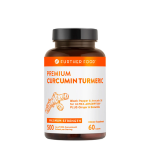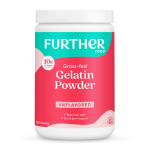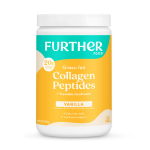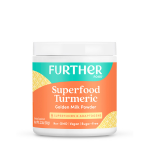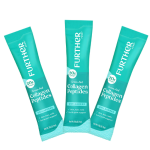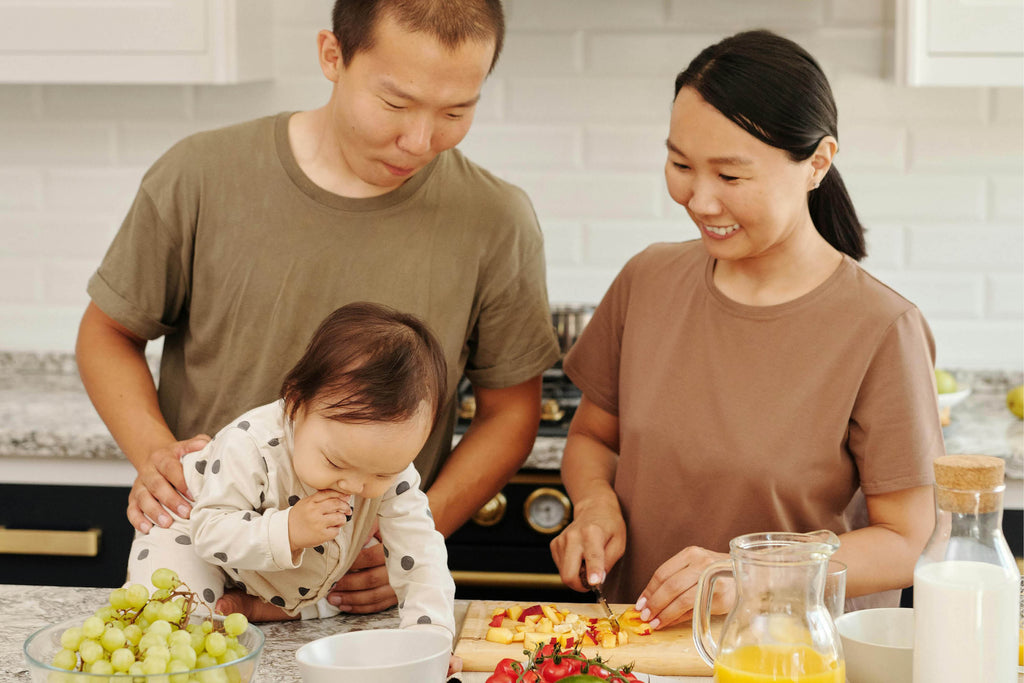By: Ally Owen
Do you want to know if your baby is ready for solids and what first foods they should eat? As a holistic nutritionist and occupational therapist who has recently had a baby, I can help! I believe that making sure your baby eats nutrient rich foods early on is key to giving them a strong foundation for long term good health. Read on to learn what signs to look for to see if your baby is ready for solids and then what foods to offer.
How To Know When Baby is Ready for Solid Foods
First of all, it is important to wait for all signs of readiness, because if your baby starts solids before they are truly ready, you will miss out on the development of preceding foundational skills that will contribute to successful feeding later on (for example, postural control, chewing skills, oral motor skills, fine motor skills/coordination. etc.) There is no need to rush it, and being patient will make the whole experience smoother for everyone involved!
In no particular order, these are four main skills that your baby should demonstrate and/or be able to do before you start solids with them. While typically this is around six months of age, it’s more important to ensure your baby is truly ready instead of just going by a specific date on the calendar. I do recommend waiting until at least 6 months, even if your baby is showing these signs, because their gut microbiomes are still too immature before 6 months.
1. Ability to maintain head control and sit upright without support, or with minimal support from their high chair, for the approximate duration of a meal (ideally 10+ minutes) If your baby cannot maintain head control in an upright seated position (regardless of their age), they are definitely not ready for solids! Proper postural control in a seated position is important for optimal digestion and safe swallowing, as well as for the fine motor control to actually be able to eat. You can practice this skill with them sitting in their high chair with you at meals before you even introduce any foods
2. Interest in eating Your baby should show interest in others when they are eating and reach/look at their food. This means your baby will be motivated by the food and ensures they won’t feel ‘forced’ into eating; which would likely lead to resentment, aversion, etc. The longer you wait to start solids, the more this interest should grow, although I find that between 6-7 months is the peak interest timeframe. The best way to increase your child’s interest in this area is to include them at the table during mealtimes even before they’re actively participating in eating.
3. Ability to reach for, pick up, and bring objects to the mouth/midline with both hands, in a semi-controlled manner If your baby is not bringing their hands or items to their mouth, then they are not going to be able to figure out how to self-feed, which is important to help Baby gain independence with feeding (which means less work on the parents' part).
4. Baby shows emerging skills to imitate and make chewing motions with their jaw, and does not have a hyper-sensitive gag reflex The ability to chew is obviously very important for eating, and while it’s not expected for infants at this age to actually be chewing their food with teeth, it’s very important for them to learn the motor skill and develop the muscles to do so. This can be accomplished by imitation, mirror feedback, using long/rod-like teethers (these are actually the top type of teether I recommend because they also work on moving the gag reflex further back in the mouth, which will also help to decrease gagging when starting solids), and ‘food teethers’ - think thick carrots, sprigs of asparagus, a cleaned meat bone, and other things they can safely munch on that won’t carry any choking risk.
Note that if you are concerned about your child’s readiness or their ability to do some of the skills mentioned above, you may want to seek out a therapy evaluation.
What Solid Foods to Feed Your Child
As you start introducing foods to your child, remember that eating is largely a sensory experience early on. Until the age of one, your baby’s primary source of nutrition should still be coming from breastmilk or formula. It will definitely be messy, as your baby will do a lot of playing, and might not consume the quantity of food you are expecting them to, but it’s all part of the experience! Stay the course and their consumption will increase.
In terms of what to feed your child, it is extremely important to make sure your baby is eating nourishing and nutrient dense foods as this helps to create a strong foundation for gut health and immune health long-term. As we’re all very well aware, chronic illness is increasing in younger populations and so many children are suffering from conditions that were unheard of in their age group before. I believe this is, in part, due to our modern diet being devoid of so many crucial nutrients that children need to grow and develop optimally. Luckily, if any aspect of the rise in chronic childhood illnesses is due to poor diet, many of these issues can be prevented or reversed by eating a nourishing diet. This is my driving force and main goal when I feed my daughter. Every single meal I feed her is an opportunity to shape her future health - and that is a responsibility that I do not take lightly.
Below is a comprehensive list of some of the foods that I recommend and that I gave my daughter. Although some of these foods may seem “weird” to our established and stubborn adult palates, I promise you that babies love them! (My daughter cannot get enough bone marrow & raw cheese!) Partially because they are ancestrally primed to eat these foods that our ancestors had access to, but also because they are packed full of nutrients that babies are craving as they’re developing rapidly!
Also, as you start solids, make sure to incorporate a VARIETY of textures and tastes to establish a diverse palate and refine oral motor skills. It is also important to prioritize the highest quality foods (organic fruits & veggies, minimal/no packaged processed foods, foods without additives/dyes/flavorings, etc.), since babies’ guts are so much more fragile than ours are as adults.
List of Foods to Feed Baby
Ideally, your baby’s first foods should contain protein, fat, cholesterol, and absorbable iron and zinc. Root vegetables are a great, easily digestible vegetable option for young babies. Babies require key nutrients for brain health and immune boosting when starting solids: iron, vitamin D, zinc, and omega-3 fatty acids.
Protein: Growing children need a lot of protein, and protein deficiency negatively impacts the body’s ability to build enzymes and antibodies necessary for immune functioning and fighting off illnesses. Some protein sources I recommend are:
-raw, grass-fed, organic dairy & cultured dairy. Raw dairy is not at all scary like the modern food system has made it out to be - it’s a whole food packed full of nutrients! pasture-raised animal meats.
-red meat is the richest source of bioavailable heme iron.
-liver (rich in zinc, iron, choline, copper, omega-3s, tryptophan, and antioxidants) & other organ meats (heart, kidney, tongue) from pastured, organically raised animals. I recommend cooking organ meats in raw butter or ghee and then pureeing them with breastmilk for an easy first food.
-bone marrow & bone broth: Bone marrow is rich in immune-boosting nutrients, iron, vitamin A, and phosphorus and incredibly easy to make - just roast bones from pastured beef, scoop out the marrow while it’s warm, and whip it up! Bone broth contains gelatin which supports digestion and is rich in minerals and electrolyte.
-eggs from organic, pasture-raised chickens. Feed baby just the yolk first will help decrease any reactions to the proteins in the egg whites that some people have issues with digesting.
-wild-caught seafood (Alaskan salmon, sardines, mackerel, oysters, haddock, cod, shrimp, etc.) & fish roe/eggs.
High quality fats: Fats are incredibly important for the growing baby (especially their brain), because minerals cannot be utilized or absorbed without an adequate quantity of consumed fat-soluble activators. This includes cod liver oil which is rich in DHA, vitamins A & D3, and fatty acids to fight inflammation. Cod liver oil supports cellular communication and nervous system function, and it assists the colonization of probiotics in the gut.
-Saturated fats: Saturated fat is necessary for cell structure and cell wall integrity, absorption and use of fat-soluble nutrients (like vitamins A, D, E & K), mineral absorption, fueling cardiovascular function (the heart uses fat for fuel), supporting healthy lung tissue and ensuring bone strength. Some examples include high-vitamin butter oil, raw butter, ghee, tallow, lard, and coconut oil.
-Cholesterol-rich foods, like butter, can help the body reduce its own cholesterol production so that it regulates what is needed for healthy physiological functioning. Cholesterol is also an antioxidant; it is important for protecting cellular and nervous system function, as well as brain communication. The body also uses cholesterol to make hormones and metabolize vitamin D, as well as help with digestion.
Probiotic foods (like sauerkraut, kefir & yogurt) contain lactic acid (for immune/intestinal health), antioxidants, and enzymes (support white blood cells for fighting pathogens).
Celtic/Himalayan sea salt. Salt is also crucial for protection against parasites and other infections.
Starting solids should be a fun, and low-stress experience for you and your baby! Make sure your baby is ready and slowly introduce some of the foods I have listed. If you have any questions or need additional help, please feel free to check out my blog or Contact Me.
ABOUT Ally Owen:
I am an Occupational Therapist, Holistic Nutritionist, and Gillespie Approach Trained Craniosacral Fascial Therapy Practitioner. I am passionate about blending all of my experience and interests in a way that empowers you on your journey to live a freely nourished lifestyle full of nourishing foods and participating in nourishing activities while feeling your absolute best. Blending my passions of occupational therapy and holistic nutrition helps me to look at you as a whole person that is comprised of dynamic physiological needs that interact with your environment in ways that either promote or impede wellness.








